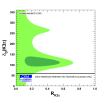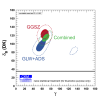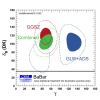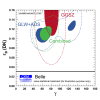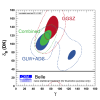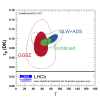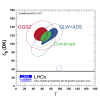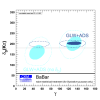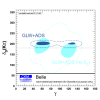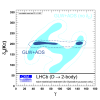(FPCP 2013 conference)
Menu:
|
The results of the global CKM analysis include:
|

Numerical Results |
The global CKM fit in the large (ρ-bar,η-bar) plane:
| Constraints in the (ρ-bar,η-bar) plane. The red hashed region of the global combination corresponds to 68% CL. |
|
||||
| Constraints in the (ρ-bar,η-bar) plane. The |Vub| constraint has been splitted in the two contributions: |Vub| from inclusive and exclusive semileptonic decays (plain dark green) and |Vub| from B+→τ+ ν (hashed green). The red hashed region of the global combination corresponds to 68% CL. |
|
Constraints on the angle α/ϕ2 from charmless B decays:
|
Constraints on α/ϕ2 from B→ρπ (BABAR, Belle and WA),
with compared to the prediction from the global CKM fit (not including the α-related measurements) |
|
||||
|
Constraints on α/ϕ2 from the combination of B→ππ, ρπ, and ρρ for BABAR, Belle and WA,
with compared to the prediction from the global CKM fit (not including the α-related measurements). |
|
||||
| Constraints on α/ϕ2 from B→ππ, ρπ and ρρ (WA) compared to the prediction from the global CKM fit (not including the α-related measurements). |
|
Constraints on the angle γ/ϕ3
from B decays to charm:
| The references of the observables from charged B → D(*)K(*) decays (GLW+ADS) and Dalitz analyses (GGSZ) from BaBar, Belle, LHCb are included in the summary of inputs and results file | |||
We also use the inputs from charm (combining observables from charm mixing, CPV and ψ(3770) results):
|
|
|
Constraints on γ combining results from
D(*)K(*) decays (GLW+ADS) and Dalitz analyses
(GGSZ) from BaBar, Belle, LHCb and world average : compared to the prediction from the global CKM fit (not including these measurements): γ[fit] = (69.7+1.3-2.8)° |
|||||
Constraints on γ from world average
D(*)K(*) decays
(GLW+ADS) and Dalitz analyses (GGSZ) (methods shown separately):
|
|
Constraint on the ratio of interfering amplitudes rB
of the decay B → DK from world average
D(*)K(*) decays (GLW+ADS) and Dalitz
analyses (GGSZ):
|
|
|||
Constraint on the strong phase between the interfering
amplitudes of the decay B → DK from world average
D(*)K(*) decays (GLW+ADS) and Dalitz
analyses (GGSZ):
|
|
| Illustration of the correlation between the determination of γ and the ratio of interfering amplitudes rB (the strong phase difference δB) of the decay B → DK from world average D(*)K(*) decays (GLW+ADS) and Dalitz analyses (GGSZ). |
|
||||
| Same using only Babar inputs. |
|
||||
| Same using only Belle inputs. |
|
||||
| Same using only LHCb inputs. |
|
| Illustrations of the correlation between the determination of γ determined with the GLW+ADS observables and the strong phase difference δD for BaBar, Belle, LHCb and all experiments combined. |
|
||||
| Comparison of the strong phase δD(Kπ) obtained from charm inputs (green dotted), from GLW+ADS observables (blue) and from GLW+ADS+GGSZ observables (red) |
New physics in neutral-meson Mixing:
|
Numerical inputs, results and confidence intervals are given in the detailed discussion of inputs and results. |
|
In scenario I we have introduced NP in
M12q = M12SM,qΔq independently for Bd, Bs and K, corresponding to NP with arbitrary flavour structure. Constraints on New Physics in the (ReΔd,ImΔd) plane. A 1.5 σ deviation is obtained for the 2-dimensional SM hypothesis Δd = 1 (Re(Δd)=1, Im(Δd)=0). |
|
|
Constraints on New Physics in the (ReΔs,ImΔs) plane.
A 0.0 σ deviation is obtained for the 2-dimensional SM hypothesis Δs = 1
(Re(Δs)=1, Im(Δs)=0).
The pulls for the relevant observables are 0.2 σ for B->τν, 2.9 σ for φsJ/Ψ Φ and 3.4 σ for ASL, illustrating the difficulty to accomodate the last two results in this scenario. |
| Prediction for Br(Bs→μ+ μ-)=(3.63+0.21-0.34)x10-9. The blue (respectively red) curve represents the prediction removing the input from Δ ms (respectively fBs). The red curve is actually identical to the green one, indicating that the prediction is dominated by the indirect determination of fBs through the global fit (more specifically Δms), and not by its direct input. |
The global CKM fit in the (|Vud|,|Vus|) plane:
| Constraints in the (|Vud|,|Vus|) plane. The indirect constraints (coming from b transitions) are related to |Vud| and |Vus| through unitarity. The red hashed region of the global combination corresponds to 68% CL. | |
| The accuracy recently reached by kaon leptonic decays K→eν and K→μν requires the inclusion of the full set of universal radiative corrections described in Marciano-Sirlin 1993. The agreement is then very good between the measurements and the prediction of the global fit without these observables. |
The global CKM fit in the (|Vcd|,|Vcs|) plane:
| Constraints in the (|Vcd|,|Vcs|) plane. The indirect constraints (combing from b and s transitions) are related to |Vcd| and |Vcs| through unitarity. The direct constraints combine leptonic and semileptonic D and Ds decays as well as information from neutrino-nuclaon scattering and W → cs decays. The red hashed region of the global combination corresponds to 68% CL. | |
| Constraints in the (|Vcd|,|Vcs|) plane where direct constraints involve only leptonic D and Ds decays with our inputs for lattice averages. | |
| Constraints in the (|Vcd|,|Vcs|) plane where direct constraints involve only semileptonic D and Ds decays with our inputs for lattice averages. | |
| Constraints in the (|Vcd|,|Vcs|) plane where direct constraints involve only information from neutrino-nucleaon scattering and W→ cs decays (no lattice input). |
Constraint from the B+→τ+ ν branching ratio:
| The recent update of BR(B→τν) from Belle has led to a decrease of the world average. The discrepancy in the CKM global fit between the world averages for sin2β and BR(B→τν) has thus been eased significantly. | |
| There is a specific correlation between the two quantities in the global fit which is best viewed in the (sin2β,BR(B→τν)) plane, regarding the prediction from the global fit without using these measurements. The cross corresponds to the experimental value with 1 sigma errors. | |
| The constraint can also be seen from the point of view of lattice inputs, with the predictions on the decay constant fBd and fBd Sqrt[BBd] | |
The global CKM fit in the small (ρ-bar,η-bar) plane (zoom):
| Zoomed constraints in the (ρ-bar,η-bar) plane.The red hashed region of the global combination corresponds to 68% CL. |
|
||||
| Zoomed constraints in the (ρ-bar,η-bar) plane. The |Vub| constraint has been splitted in the two contributions: |Vub| from inclusive and exclusive semileptonic decays (plain dark green) and |Vub| from B+→τ+ ν (hashed green). The red hashed region of the global combination corresponds to 68% CL. |
|
||||
| Zoomed constraints in the (ρ-bar,η-bar) plane not including the angle measurements in the global fit. |
|
||||
| Constraints in the (ρ-bar,η-bar) plane including only the angle measurements. |
|
||||
| Constraints from CP conserving quantities (|Vub / Vcb|, Δmd, (Δmd and Δms) and B+ →τ+ ν) in the (ρ-bar,η-bar) plane. |
|
||||
| Constraints from CP violating quantities (sin(2β), α, γ and εk) in the (ρ-bar,η-bar) plane. |
|
||||
| Constraints from "Tree" quantities in the (ρ-bar,η-bar) plane (γ(DK) and α from the isospin analysis with the help of sin2β (charmonium), which gives another tree only γ measurement (the only assumption is that the ΔI=3/2 b-->d EW penguin amplitude is negligible)). |
|
||||
| Constraints from "Loop" quantities in the (ρ-bar,η-bar) plane. |
|
||||
| Constraints in the (ρ-bar,η-bar) plane, not including the braching ratio of B+ → τ+ν in the global fit. |
|
||||
| Constraints in the (ρ-bar,η-bar) plane not including the measurement of sin2β in the global fit. |
|











